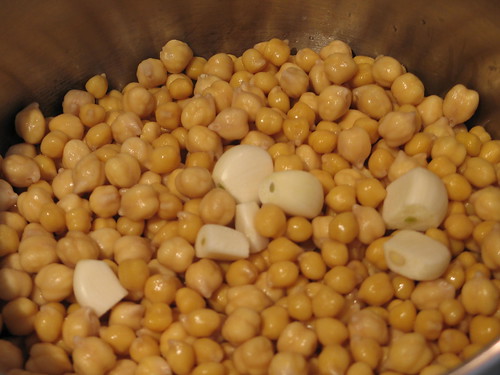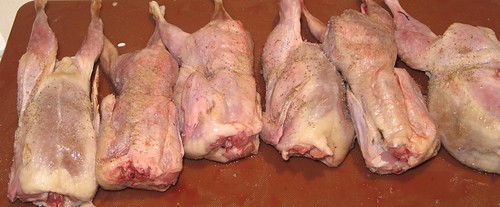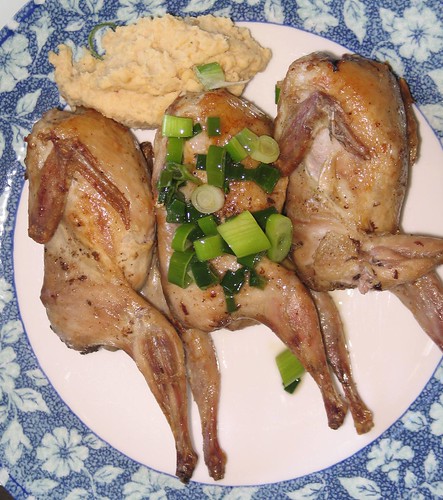After I’d gone all out baking cookies, I had a brief period where I wasn’t sure what to cook next (and I was still finding dried icing in my kitchen!). As previously when I have run out of inspiration, I turned to Fergus Henderson. Although I haven’t been brave enough to tackle a pig’s head yet, I’m a huge fan of Henderson’s way of cooking and general philosophy – and I hope one day to visit his restaurant in London.
In his Nose to Tail Eating, Henderson provides a recipe for pigeon, chickpeas and spring onion. I didn’t have easy access to pigeons (well, the edible kind anyway…there’s lots around the park!) so thought I’d combine the flavour elements of this dish with Henderson’s instructions for cooking quail, which were available from the poultry store.
First, I had to prepare the chickpeas. I started with dried chickpeas, and soaked them overnight (the recipe says 500g but I used less as I was only cooking for 2). I drained them, added garlic, salt and pepper, and covered them with water. I simmered them for just under 2 hours, until they were soft.

Once the chickpeas were almost done, I started preparing the quail. Again I used Henderson’s recipe in Nose to Tail Eating, which describes a simple way of preparing and cooking the quail. First, I seasoned them with salt and pepper well, both inside and outside.

Next, I used some olive oil to brown the quails, two by two, in a pan.

They browned fairly quickly, and I put them on an oiled tray and stuck them in the oven for 20 minutes. While the quail were cooking, I went back to prepare the chickpeas and the spring onion. In his recipe, Henderson suggests serving the original pigeon with spring onions. I decided to make a sauce out of the spring onions to add a different texture and flavour to the dish.
I used a sauce I originally learned to make with an Chinese-style steamed chicken recipe. It’s simple: sesame oil, salt, and the spring onions. You put some sesame oil in a saucepan, and add some salt (a fair amount). You heat it slowly until the salt has dissolved, and then add the spring onions. Let them cook slightly – I cooked them until they were soft, but still green and not crispy. Once they’ve cooked sufficiently, take the saucepan off the heat to cool the sauce down – serve the sauce at room temperature.

I also prepared the chickpeas by draining the water, and pureeing half the chickpeas in a blender with tahini, more garlic, lemon juice, tabasco sauce and olive oil – you’re making hummus, essentially. Once they were blended, I added the remaining chickpeas but didn’t blend them as much, to give a bit of texture to the chickpeas. The recipe suggests that a thinner consistency is good, rather than a “thick glump”, and I think if I were making this again, I’d make the chickpeas thinner as the end result was still fairly thick.

By this time, the quail was ready. I served the quail with the chickpeas on the side, and some of the sesame and spring onion sauce over the top.

My immediate thought was, “my quail are doing the can can!” Once I’d got over that, I was pleasantly surprised by how moist and juicy the quail were. They were cooked to the point where it was easy to pull the legs off, and the meat was tender and succulent. The salty quail contrasted nicely with the garlicky, tangy chickpeas. The sesame and spring onion sauce tied the whole dish together, providing a kick of sesame which worked well with the quail meat.
While the pigeon in the original recipe would have been gamier, and probably provided a greater contrast with the chickpeas than the quail did, this was still a satisfying meal, and the flavours all worked well together. While quail does not feature prominently in the Nero Wolfe stories, I’m sure that Wolfe and Fritz would both appreciate this meal, and perhaps it may even be added to Wolfe’s usual lunchtime fare.
No comments:
Post a Comment